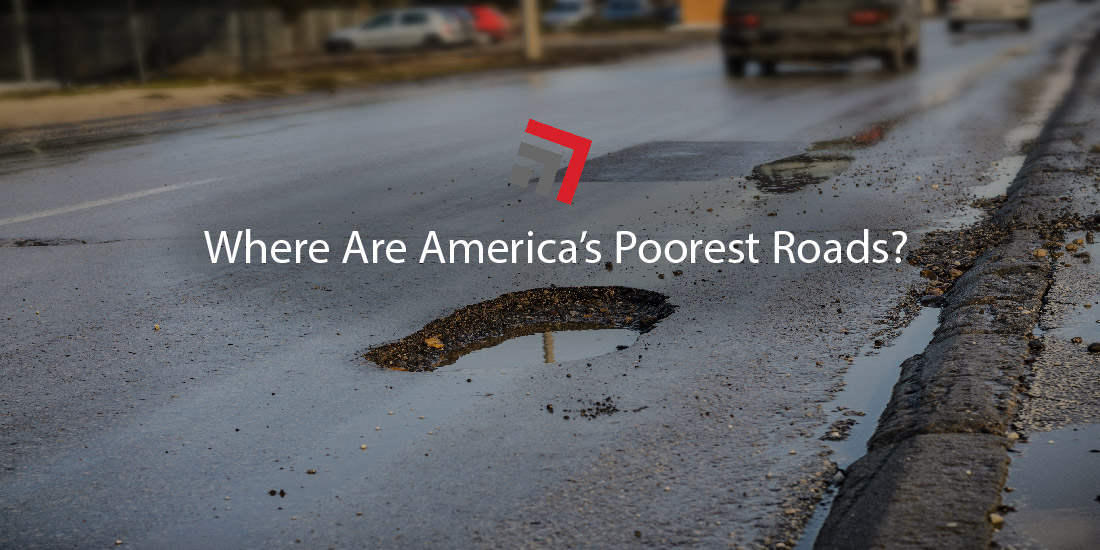Have you ever made a turn down a poorly paved road?
Typically, the decision is regretted about 30-seconds into the ride. While bouncing up and down, you’ll curse at your GPS, the device that you led astray to this pothole-ridden rabbit hole, while keeping your head on a swivel for a premature exit—hoping that anything can be better than what you just put your vehicle through.
Those blasted poorly paved roads!
Road conditions are more than a nuisance, they are costly too
Yes, just like mosquitos while camping or a coworker microwaving salmon in the break room, a bumpy road can be one of more irritable experiences we all share in life. However, the stakes are a lot higher than raw annoyance.
Poor road conditions threaten the welfare of vehicles—from a small Prius to a heavy-duty Class 8 semi. Even hitting a small pothole or bump in the road can throw off alignment. Poor alignment increases the wear and tear on tires which reduces their lifespan and hastens the need for replacements.
Moreover, a poor road can affect a vehicle’s suspension, throwing off its balance on the road. This sort of fix is costly, but necessary if it happens.
As a result, maintenance costs can quickly add up when exposed regularly to such conditions. For passenger vehicles, this could mean hundreds of dollars thrown into repairs, but for trucking companies, times that number to infinity and beyond.
Fleets operating in areas with poor roads are flirting with a high price to pay when exposing their assets to withering infrastructure.
Federal data reveals which cities have the worst roads
A natural question to ask—where are the country’s worst maintained roads?
While some folks can confirm already through anecdotal torment, Teletract Navman, a software company specialized in fleet management, compiled data on an infographic, detailing which American cities have the worst roads in the country.
Teletrac defined road condition by using data from an annually calculated federal index that measures pavement smoothness and a federal pavement condition rating, known as the Present Serviceability Rating.
Both sources are overseen by the Federal Highway Administration, an agency under the U.S. DOT.
Wielding this data, Teletrac then came up with four distinct ratings for pavement conditions: poor, mediocre, fair, and good.
Clearly, poor is the worst and characterized as deteriorated, passable at only reduced speeds, and peppered with large cracks and potholes.
While, good is the most ideal. Under this label, roads are typically newer, recently paved, and offer a smooth, distress-free, ride for motorists.
Teletrac then proceeded to attach these ratings in percentages to large U.S. cities. For example, Austin, Texas’ capital city, had 16 percent of its roads defined as “poor”, while 44 percent defined as “good”. Not too shabby, Austin.
Where are the poor roads?
According to the data wizardry, the city with the worst-maintained roads in the country is San Francisco.
The Bay Area city had 71 percent of its roads defined as “poor” while only six percent were marked as “good”.
Following San Francisco is its nearby neighbor San Jose. The Californian city saw little improvement to its Bay Area counterpart with 64 percent of roads defined as “poor” and a mere nine percent passing as “good”.
And, if motorists still haven’t taken a hint on whether California is a questionable place to spin their wheels, the Los Angeles metro scored third on the list. If there’s any silver lining, the city was able to crack double-digits in the good department—ten percent of its roads were given good marks.
Rounding out the top ten were (in order): Honolulu, HI; Milwaukee, WI; Akron, OH; Cleveland, OH; New York-Newark, NY-NJ; Providence, RI; and, Philadelphia, PA.
Show us the good roads!
While the study does its justice of highlighting where America’s problem roadways are, it also recognizes cities where driving is a bit smoother.
Orlando, FL was penned the country’s top city for road conditions. 69 percent of the roads in the area were rated as “good”.
Though interestingly enough, Orlando had 21 percent of roads marked as “poor”. This indicates the city has quite a bizarre road situation, with few roads marked as “mediocre” or “fair”.
Atlanta was a close second with 66 percent rated as “good”, while Boston was right behind with 65 percent.
Rounding out the top ten were (in order): Jacksonville, FL; Portland, OR; Springfield, MA; Nashville, TN; Tampa, FL; Las Vegas, NV; Birmingham, AL; and, Raleigh, NC.
Final Thoughts
In addition, Teletrac also noted average repair costs for individuals from poor road conditions. Unsurprisingly, San Francisco also captured the crown with motorists cowboying up to $1,049 in maintenance costs.
On the other hand, Rochester, NY and Boston came up as the lowest in repair costs. On average, motorists only cough up $305 and $306, respectively.
Please contact us if you have any questions regarding this topic or any others in domestic logistics. In addition, stay up to date with weekly headlines from both trucking and rail via our Road Map newsletter.
More blogs like this:



Recent Comments